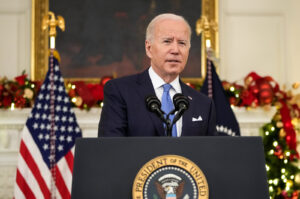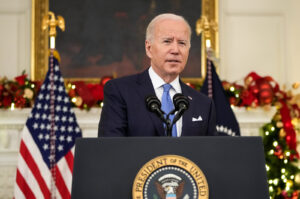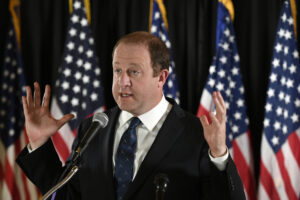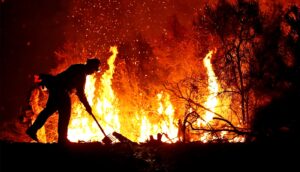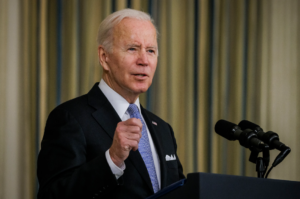Amid the COVID-19 chaos, the US election train rolls on
6 min read
They say 24 hours is a long time in politics. So, three weeks must be near an eternity.
On the morning of 29 February, Bernie Sanders appeared destined to win the Democratic presidential nomination. Three weeks later, his candidacy appears all but doomed.
On the same February morning, Joe Biden’s candidacy was flatlining. Three weeks later, he’s amassed victories in 19 states to hold a 300-delegate lead. He now seems almost certainly the party’s champion.
On that very February morning, the United States reported its first death from COVID-19. Three weeks later, that number has passed 600.
Three weeks is a long time.
The political impact of COVID-19
The impact of COVID-19 on daily life globally has been profound and politically destabilising. Governments worldwide are scrambling to enact sweeping stimulus packages, many of which would have been impossible to pass under other circumstances.
In the United States, the major parties are jostling to pass competing large-scale, sweeping stimulus measures. On the Republican side, Senate majority leader Mitch McConnell is attempting to push through a mammoth US$1.8 trillion measure, although it’s been halted at stalemate on the Senate floor. Not to be outdone, Speaker Nancy Pelosi unveiled the Democrats’ $2.5 trillion stimulus plan to be pursued by the House.
All the while, cases of COVID-19 increase rapidly – both among the American public and elected officials. Senator Rand Paul of Kentucky is among those who tested positive for the virus, while others in Congress are voluntarily self-isolating.
Despite disagreements on how funds are distributed to individuals and businesses, quick passage of legislation is considered vital to stimulate a flagging economy gripped by a rising death toll and the spectre of fear.
A tale of two executives: the President and the governors
President Donald Trump’s response to COVID-19 has, predictably, been met with mixed reviews. Criticism has been levelled at Trump for inflated optimism, for contradicting the words of his experts, and for fanning the flame of the theory that COVID-19 is merely the Democrats’ “new hoax” (without explicitly stating these words). At the same time, Dr Anthony Fauci and Dr Deborah Birx have been hailed for their frank assessments of the pandemic’s spread, and their actions in response.
Polls indicate that just under half of the US electorate is satisfied with Trump’s crisis management; yet, note that this appears consistent with his presidential performance generally, which rarely falls below 40 per cent and scarcely rises into the high 40s. Trump’s performance, or at least public perception thereof, is noticeably lacklustre compare to that of his 50 sub-national counterparts.
While there will be, at an uncertain time, a Democratic presidential nominee, their coronation as party champion might be delayed.
The US, as a federal system, grants a great deal of autonomy to its 50 states. As such, state executives are playing large roles in the response to COVID-19, for which they are receiving praise not limited by party of geography. For instance, Republican Governor DeWine of Ohio was lauded for his swift action to postpone his state’s primary elections in a similar manner to that bestowed upon Democratic Governor Cuomo of New York for his actions to increase hospital capacities. Arguably, the American public consider their governors are filling a void in crisis management vacated by their president.
This state-federal divide is reflective of the situation at home in Australia. Where the US governors and Australian premiers can cater closely to the needs of smaller constituencies, both President Trump and Prime Minister Scott Morrison appear to have inherited a poisoned chalice. Regardless of their decisions, they’re unable to balance the competing interests of a multitude of states to receive broad-reaching and bipartisan acclaim.
The primary campaign will continue
Meanwhile, for the first time in several election cycles, the presidential election has become, at best, a secondary focus for the American media. Yet, the race continues.
Following losses in the first three states, Biden has won 19 states to Sanders’ five. Now, about 60 per cent of delegates have been allocated such that the former vice-president has a near insurmountable lead.
The next major prize is Wisconsin, a critical Midwestern state at the November election, which will distribute its 84 delegates on 7 April. One might assume that a failing here for Sanders might spell his candidacy’s conclusion; however, cast your mind back to 2016 when the Vermont senator battled Hillary Clinton to the bitter end.
The campaign, naturally, has been hampered by COVID-19. On 15 March, we witnessed the first debate without a live audience in decades. Concern surrounding the virus depressed voter turnout, particularly in Arizona, Florida and Illinois, which voted on 17 March. Additionally, eight other states have postponed their primaries. These eight states combine for 613 delegates, which may assist in delaying Sanders’ seemingly inevitable withdrawal.
While there will be, at an uncertain time, a Democratic presidential nominee, their coronation as party champion might be delayed. With restrictions on gatherings, the national conventions will likely be postponed or cancelled. Although these events might appear to be built on pomp and ceremony, they provide significant financial gain to their host cities. As such, the cities of Milwaukee, Wisconsin and Charlotte, North Carolina (scheduled to host the Democratic and Republican conventions, respectively) would lose significant revenue. Note that these cities are both situated in swing states.
Could the presidential election be delayed?
In short, postponement of the 3 November presidential election is a near impossibility.
First and foremost, the 20th amendment to the Constitution sets plain that the new Congress shall be sworn in at noon on 3 January, while the new president be sworn in at noon on 20 January. By law, the elections must take place to allow the swearing in of these officeholders with all votes counted.
Additionally, in 1845 legislation was enacted that required general elections for federal offices to take place on “the Tuesday next after the first Monday in the month of November”, thus placing this year’s election on 3 November.
To alter this would require not only the assent of the President, but Congressional approval. Speaker Pelosi and the House Democratic majority are unlikely to support any measure that could prolong President Trump’s White House tenure.
A once-hot topic, now peripheral
In any other election cycle, when it appeared clear who the nominee would be, the bulk of discussion would move to the general election matchup now likely between Joe Biden and Donald Trump. Yet in light of present circumstances, what would usually be a topic of much speculation is now peripheral.
No, I’m not thinking of the absent comparisons between the Biden and Trump policies designed to shape American in the 2020s; nor am I contemplating the higher risk COVID-19 poses to those aged over 70 – a group that includes Biden, Sanders and Trump – although these topics certainly warrant discussion. Instead, take a moment to contemplate a potentially historic commitment made by Joe Biden: to select a female running mate.
No female candidate has been on a winning ticket as either a candidate for president or for vice-president – aside from Hillary Clinton in 2016, remember VP candidates Geraldine Ferraro (1984) and Sarah Palin (2008).
Joe Biden will be counting his blessings that he has a deep pool from which to pick the woman who could be a heartbeat from the presidency.
Let’s conclude by briefly discussing some of the potential running mates for Joe Biden this November.
Vanquished rivals Kamala Harris, Elizabeth Warren and Amy Klobuchar are all in the mix, yet would add different strengths to the Democratic ticket. Harris adds her prosecutorial record, attractive to Democrats in the Trump era, as well as minority appeal; Warren would help solidify the liberal wing of the party behind Biden; and Klobuchar would bolster his hopes of winning key Midwestern states in November, including her home state of Minnesota.
By the same token, adding Governor Gretchen Whitmer of Michigan to the fold would almost certainly paint her state blue. Stacey Abrams would bring Southern appeal and bolster Biden’s African-American support. Meanwhile, Representative Val Demings, a House impeachment manager last year, could do the same and swing her home state of Florida. And Michelle Lujan Grisham, Governor of New Mexico, could boost the Hispanic vote for Democrats and help Biden in neighbouring Arizona and Texas.
There are many more names to consider, and more reasons why those listed above could assist the Biden ticket. Joe Biden will be counting his blessings that he has a deep pool from which to pick the woman who could be a heartbeat from the presidency.
In the meantime, the former VP will likely benefit from relative silence and a stable considering COVID-19 and President Trump’s erratic response.
The Article was originally published on Amid the COVID-19 chaos, the US election train rolls on.

